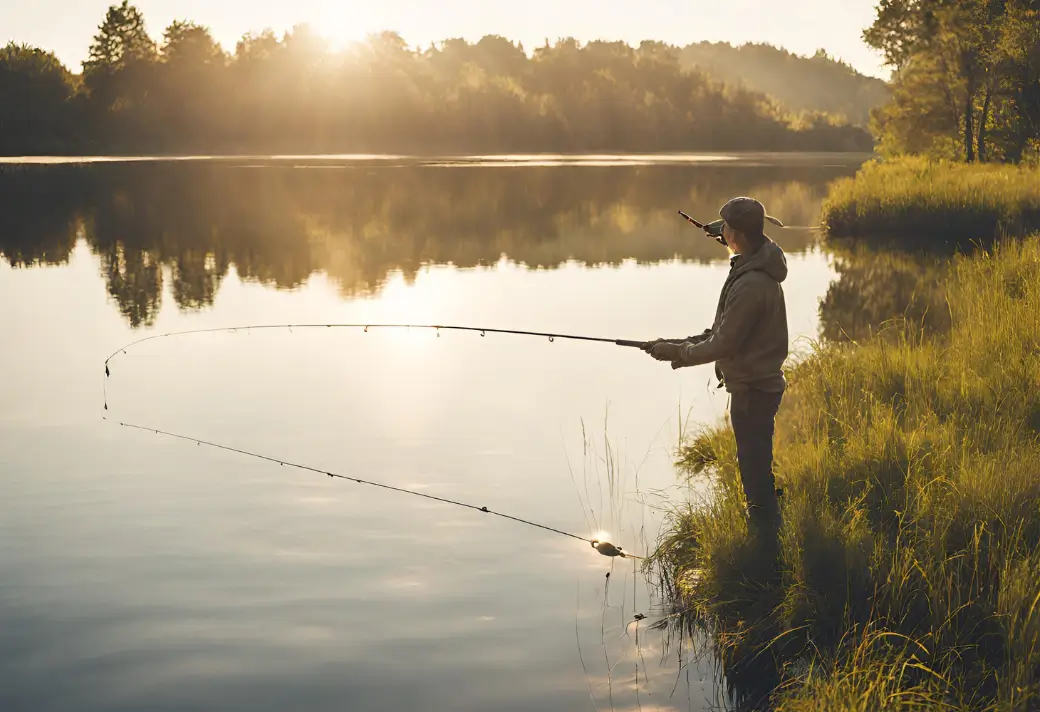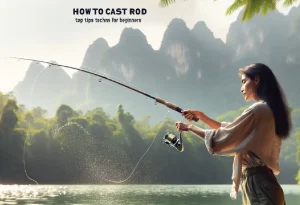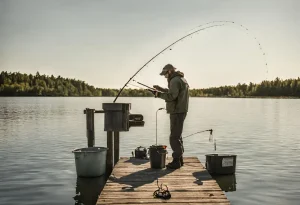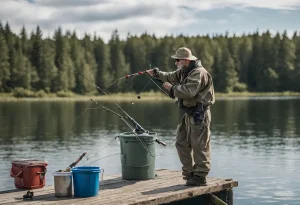As a beginner angler, stepping into the world of fishing can be both exciting and overwhelming. With so many different types of fish to choose from, it can be daunting to decide which ones are the easiest to catch. However, fear not! In this article, I will guide you through the process of choosing the right fish for beginners and provide you with tips for a rewarding fishing experience. So, let’s dive in and discover the easiest fish to catch for beginners!
Factors to consider when choosing fish for beginners
Before we delve into the specific types of fish, it’s important to consider a few factors when choosing fish for beginners. First and foremost, you need to determine the accessibility of the fishing spot. Look for places that are easily accessible, such as public fishing piers or stocked ponds, as they are more likely to have abundant populations of fish that are easier to catch.
Another factor to consider is the behavior and feeding habits of the fish. Some fish species are more active and aggressive feeders, making them easier targets for beginners. Additionally, the size of the fish matters too. Larger fish tend to put up a stronger fight, which can be challenging for beginners. So, it’s best to start with smaller fish that are easier to handle.
Easiest fish to catch for beginners – Panfish
Panfish, such as bluegill and sunfish, are often considered the easiest fish to catch for beginners. These small fish are abundant in many freshwater bodies, making them easily accessible for novice anglers. Panfish are also known for their voracious appetite, which means they are more likely to bite on a variety of bait and lures.
To catch panfish, you can use simple fishing techniques such as bobber fishing or casting with light tackle. Live bait, such as worms or crickets, works well for panfish. Alternatively, you can try using small artificial lures, such as jigs or spinners, to entice the fish. Remember to fish near structures, such as fallen trees or weed beds, as panfish often seek shelter in these areas.
Tips for catching Panfish
- Use light tackle: Panfish have delicate mouths, so it’s important to use light fishing gear to prevent tearing the hook out of their mouths when they bite.
- Fish near cover: Look for areas with vegetation or fallen trees where panfish like to hide. These structures provide shade and protection, making them ideal feeding spots for panfish.
- Be patient: Panfish can be finicky eaters, so be patient and wait for them to strike. Avoid making sudden movements that could scare them away.
Easiest fish to catch for beginners – Catfish
Catfish are another excellent choice for beginners due to their willingness to bite and their relatively large size. These bottom-dwelling fish can be found in rivers, lakes, and ponds, making them accessible to anglers of all skill levels. Catfish are known for their strong sense of smell, so using smelly baits, such as chicken liver or stink bait, can be highly effective.
To catch catfish, you can use a variety of techniques, including bottom fishing or drift fishing. Bottom fishing involves casting your baited hook onto the bottom of the water and waiting for the catfish to pick it up. Drift fishing involves using a float or bobber to suspend your bait at different depths as it drifts with the current.
Tips for catching Catfish
- Choose the right bait: Catfish have a strong sense of smell, so using bait with a strong odor, such as chicken liver or shrimp, can attract them.
- Fish during the right time: Catfish are more active during dawn and dusk, so try to plan your fishing trips accordingly.
- Be prepared for a fight: Catfish are known for their strength, so make sure to use heavier tackle and be prepared for a battle when reeling them in.
Easiest fish to catch for beginners – Trout
Trout are a popular choice among beginner anglers due to their abundance in many freshwater streams and rivers. These beautiful fish are known for their aggressive feeding behavior, making them relatively easy to catch. Trout can be found in both cold and warm water, depending on the species, so it’s important to research the specific type of trout in your area.
To catch trout, you can use a variety of techniques, including fly fishing, spin fishing, or bait fishing. Fly fishing involves casting lightweight artificial flies onto the water’s surface to imitate the insects trout feed on. Spin fishing utilizes spinning reels and lures or bait to entice the trout. Bait fishing involves using live bait, such as worms or salmon eggs, to attract the fish.
Tips for catching Trout
- Match the hatch: Pay attention to the insects present in the water and choose artificial flies that closely resemble them. This will increase your chances of attracting trout.
- Practice proper casting techniques: Trout are often found in areas with swift currents or under overhanging trees, so it’s important to practice accurate casting to reach these spots.
- Be stealthy: Trout have excellent eyesight and can be easily spooked. Approach fishing spots quietly and avoid making sudden movements that could alert the fish.
Easiest fish to catch for beginners – Bass
Bass, such as largemouth or smallmouth bass, are popular game fish that provide an exciting challenge for beginners. While they may require a bit more skill and knowledge compared to panfish or catfish, bass can still be relatively easy to catch due to their aggressive nature. Bass can be found in both freshwater lakes and rivers, making them accessible to anglers across different regions.
To catch bass, you can use a variety of fishing techniques, including casting with artificial lures, live bait fishing, or even fly fishing. Bass are opportunistic feeders, so using lures that resemble their natural prey, such as crankbaits or soft plastics, can be highly effective. Live bait, such as minnows or nightcrawlers, can also entice bass to bite.
Tips for catching Bass
- Use different types of lures: Bass can be selective in their feeding habits, so it’s important to have a variety of lures in your tackle box. Experiment with different colors, sizes, and action to find what works best.
- Fish during the right time: Bass are more active during early morning or late evening when the water temperature is cooler. Plan your fishing trips accordingly to increase your chances of success.
- Practice catch and release: Bass are a valuable resource, so it’s important to practice responsible fishing. Release undersized or unwanted bass back into the water to ensure their population remains healthy.
Other easy-to-catch fish for beginners
While panfish, catfish, trout, and bass are among the easiest fish to catch for beginners, there are many other species that can provide an enjoyable fishing experience. Some examples include crappie, perch, or even sunfish. These fish share similar characteristics with the ones mentioned earlier, such as being abundant and relatively easy to catch.
When targeting these fish, you can apply similar fishing techniques and tips mentioned in the previous sections. Remember to research the specific habits and preferences of each fish species to increase your chances of success.
Essential fishing gear for beginners
As a beginner angler, having the right fishing gear is crucial for a successful and enjoyable fishing trip. Here are some essential items you should consider:
- Fishing rod and reel: Choose a fishing rod and reel combo that is suitable for the type of fish you plan to catch. Opt for lightweight and easy-to-handle equipment for a comfortable experience.
- Fishing line: Select the appropriate fishing line based on the fish species and fishing technique you’ll be using. Monofilament lines are versatile and suitable for most beginner anglers.
- Hooks and terminal tackle: Stock up on a variety of hooks, sinkers, swivels, and bobbers to adapt to different fishing situations and techniques.
- Bait and lures: Depending on the fish species you’re targeting, bring along a selection of live bait, such as worms or minnows, as well as artificial lures that mimic their natural prey.
- Tackle box: Invest in a sturdy tackle box to store and organize your fishing gear. This will make it easier to locate and access your equipment while on the water.
Best fishing techniques for beginners
As a beginner angler, it’s important to start with simple and effective fishing techniques. Here are some techniques that are suitable for beginners:
- Bobber fishing: Attach a bobber to your fishing line and suspend your bait at a specific depth. The bobber will indicate when a fish bites, making it easier to detect and react to the strike.
- Casting and retrieving: Cast your bait or lure into the water and retrieve it with a steady or erratic motion. This technique mimics the movement of prey and can attract fish to bite.
- Bottom fishing: Place your baited hook on the bottom of the water and wait for fish to pick it up. This technique can be effective for bottom-dwelling fish such as catfish or trout.
Remember to adjust your fishing techniques based on the specific fish species and fishing conditions. Don’t be afraid to experiment and try new techniques as you gain more experience.
Safety tips for beginner anglers
While fishing can be a fun and relaxing activity, it’s important to prioritize safety. Here are some safety tips for beginner anglers:
- Wear a life jacket: If you’ll be fishing from a boat or in deep water, always wear a properly fitting life jacket to ensure your safety.
- Be aware of your surroundings: Pay attention to your surroundings, especially if you’re fishing near fast-moving water or in slippery conditions. Watch out for potential hazards such as rocks or submerged tree branches.
- Handle fish with care: When handling fish, wet your hands to minimize damage to their protective slime coat. Avoid squeezing or mishandling the fish to prevent injury to both yourself and the fish.
By following these safety tips, you can enjoy a safe and enjoyable fishing experience.
Conclusion: What Type of Fish is Easiest to Catch for Beginners
Choosing the right fish for beginners is crucial for a rewarding fishing experience. Panfish, catfish, trout, and bass are among the easiest fish to catch for beginners, thanks to their abundance and willingness to bite. By considering factors such as accessibility, behavior, and size, you can make an informed decision on which fish to target.
Remember to equip yourself with the essential fishing gear, practice basic fishing techniques, and prioritize safety while on the water. With patience, practice, and a little bit of luck, you’ll soon become a skilled angler, ready to tackle more challenging fish species. So, grab your fishing gear, head to the nearest fishing spot, and enjoy the thrill of catching your first fish as a beginner angler!
Share your favorite fishing memories or tips in the comments below!




